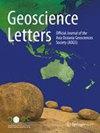Assessing hydroclimate response to land use/cover change using coupled atmospheric-hydrological models
IF 4.3
3区 地球科学
Q1 GEOSCIENCES, MULTIDISCIPLINARY
引用次数: 0
Abstract
Modeling techniques provide a straightforward means to dissect regional hydroclimate in response to changes in land use conditions. This study uses the Weather Research and Forecasting Model (WRF) and WRF-Hydrological modeling system (WRF-Hydro), driven by survey-based land use data in 1995 and 2015, to assess how central Taiwan’s hydroclimate responds to land use/cover change. We first run WRF-Hydro with observed rainfall as meteorological forcing to ensure reasonable runoff simulation, and then select ten cases under weak synoptic forcings in July and August in recent decades for the simulation under two land use conditions. The WRF-only simulation (i.e., uncoupled with WRF-Hydro) can reveal significant changes in heat fluxes and surface variables due to land use/cover change, including sensible and latent heat fluxes, 2-m temperature and specific humidity, and precipitation over the hotspots of urbanization or downwind areas. Coupling WRF with WRF-Hydro discloses varied runoff characteristics subject to land use/cover change: a general increase in average peak flow (~ 4.3%) and total runoff volume (~ 5.0%) accompanied by less definite time-to-peak flow, indicating a synergistic but sometimes competitive relationship between the pure hydrologic/hydraulic perspective and land–atmosphere interactions. By taking the difference between the uncoupled and coupled simulations, we verify that surface pressure, precipitation, and soil moisture are more sensitive to a better depiction of terrestrial hydrological processes; differences in the spatial variances of soil moisture can be as high as two orders of magnitude. Our findings highlight the importance of more comprehensive model physics in regional hydroclimate modeling.利用耦合大气-水文模式评估水文气候对土地利用/覆被变化的响应
模拟技术提供了一种直接的方法来剖析响应土地利用条件变化的区域水文气候。本研究利用气象研究与预报模型(WRF)和WRF-水文模拟系统(WRF- hydro),以1995年和2015年的调查土地利用数据为基础,评估台湾中部水文气候对土地利用/覆被变化的响应。为了保证径流模拟的合理性,我们首先以观测到的降雨作为气象强迫运行WRF-Hydro,然后选择近几十年来7月和8月10个弱天气强迫案例,在两种土地利用条件下进行模拟。仅wrf模拟(即与WRF-Hydro不耦合)可以揭示由于土地利用/覆被变化引起的热通量和地表变量的显著变化,包括感热通量和潜热通量、2 m温度和比湿度,以及城市化热点地区或下风地区的降水。WRF与WRF- hydro的耦合揭示了随土地利用/覆盖变化而变化的径流特征:平均峰值流量(~ 4.3%)和总径流量(~ 5.0%)普遍增加,但峰值流量时间不太确定,表明纯水文/水力角度与陆地-大气相互作用之间存在协同作用,但有时存在竞争关系。利用非耦合模拟和耦合模拟的差异,我们验证了地表压力、降水和土壤湿度对陆地水文过程的更好描述更为敏感;土壤湿度的空间差异可高达两个数量级。我们的发现强调了更全面的模式物理在区域水文气候模拟中的重要性。
本文章由计算机程序翻译,如有差异,请以英文原文为准。
求助全文
约1分钟内获得全文
求助全文
来源期刊

Geoscience Letters
Earth and Planetary Sciences-General Earth and Planetary Sciences
CiteScore
4.90
自引率
2.50%
发文量
42
审稿时长
25 weeks
期刊介绍:
Geoscience Letters is the official journal of the Asia Oceania Geosciences Society, and a fully open access journal published under the SpringerOpen brand. The journal publishes original, innovative and timely research letter articles and concise reviews on studies of the Earth and its environment, the planetary and space sciences. Contributions reflect the eight scientific sections of the AOGS: Atmospheric Sciences, Biogeosciences, Hydrological Sciences, Interdisciplinary Geosciences, Ocean Sciences, Planetary Sciences, Solar and Terrestrial Sciences, and Solid Earth Sciences. Geoscience Letters focuses on cutting-edge fundamental and applied research in the broad field of the geosciences, including the applications of geoscience research to societal problems. This journal is Open Access, providing rapid electronic publication of high-quality, peer-reviewed scientific contributions.
 求助内容:
求助内容: 应助结果提醒方式:
应助结果提醒方式:


